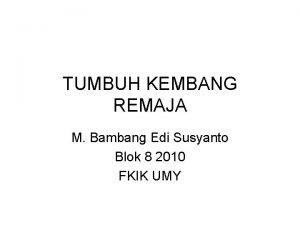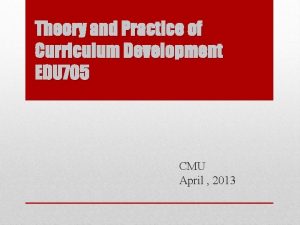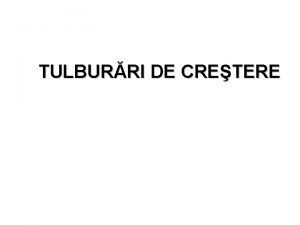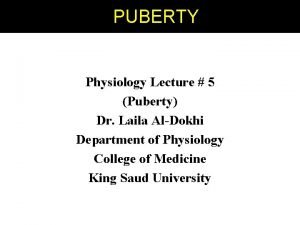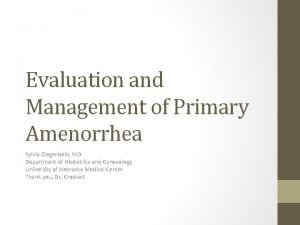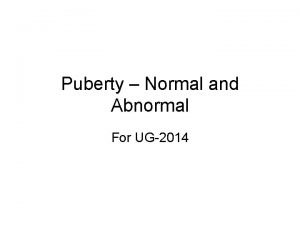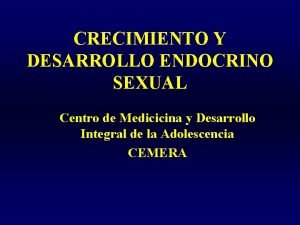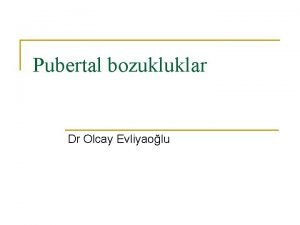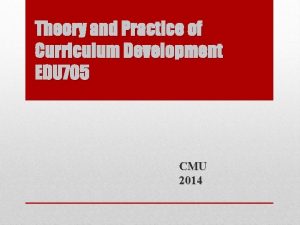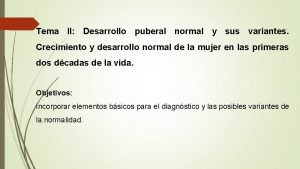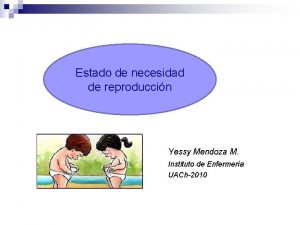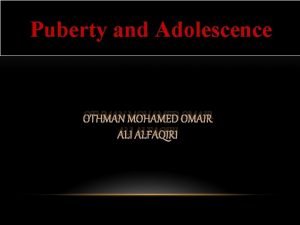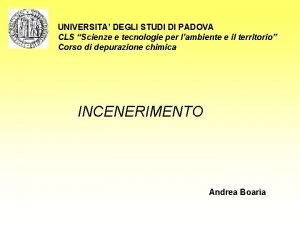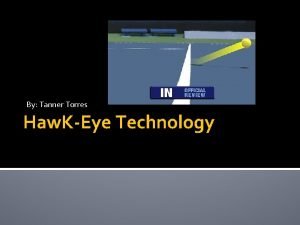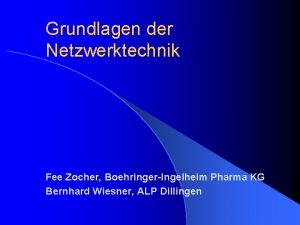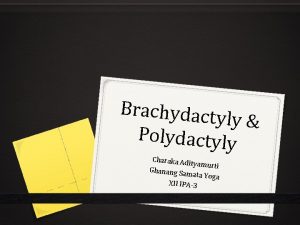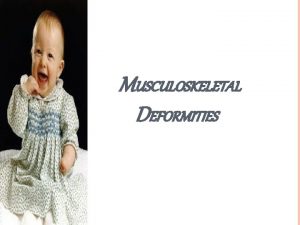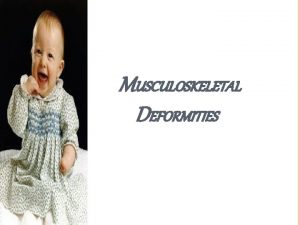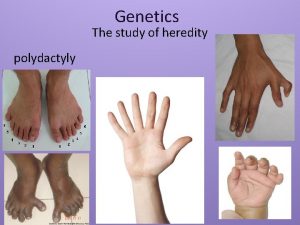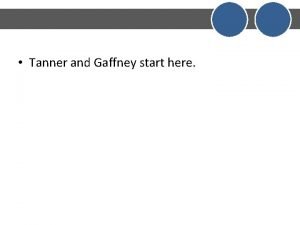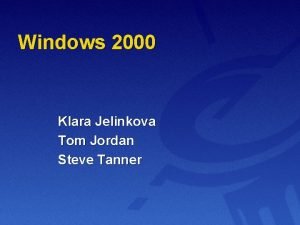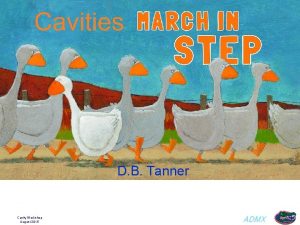Polydactyly Tanner Zocher What is polydactyly Preaxial Postaxial






















- Slides: 22

Polydactyly Tanner Zocher

What is polydactyly? Preaxial Postaxial

What causes polydactyly? GLI 3 Hh

The GLI 3 gene is associated with polydactyly C 2 H 2 zinc finger domains 1580 AA

What are zinc fingers?

What are transcription factors?

GLI 3 is part of the Hedgehog pathway Inactivated io t p i scr No n a r T Activated n cr s n a r T n o i ipt

GLI 3 is highly conserved in… C 2 H 2 zinc finger domains Human 1580 AA Mouse 1583 AA Zebrafish 1553 AA C. elegans 1110 AA Drosophila 1279 AA

What is the phylogenetic relationship?

What is the gap in knowledge? The function of GLI 3 in mediating digit number and placement is unknown.

What is the primary goal? Determine GLI 3’s role in the mechanism controlling digit count and placement

What Model Organism will be used?

How will the primary goal be reached? Aim 1: Aim 2: Aim 3: Disrupt GLI 3 zinc finger domains to link pre- and postaxial polydactyly phenotypes to the disruption of particular loci Identify temporal & local GLI 3 expression during embryogenesis Identify novel protein interactions in wildtype and mutant GLI 3 specimens

How will the primary goal be reached? Aim 1: Aim 2: Aim 3: Disrupt GLI 3 zinc finger domains to link polydactyly phenotypes to the disruption of particular loci Identify temporal & local GLI 3 expression during embryogenesis Identify novel protein interactions in wildtype and mutant GLI 3 specimens

Aim 1: Link peptide domains to polydactyly phenotypes

How will the primary goal be reached? Aim 1: Aim 2: Aim 3: Disrupt GLI 3 zinc finger domains to link pre- and postaxial polydactyly phenotypes to the disruption of particular loci Identify temporal & local GLI 3 expression during embryogenesis Identify novel protein interactions in wildtype and mutant GLI 3 specimens

Aim 2: The where and when of GLI 3 expression Embryogenesis Day 1 Day 2 Day 3 Day 4

How will the primary goal be reached? Aim 1: Aim 2: Aim 3: Disrupt GLI 3 zinc finger domains to link pre- and postaxial polydactyly phenotypes to the disruption of particular loci Identify temporal & local GLI 3 expression during embryogenesis Identify novel protein interactions in wildtype and mutant GLI 3 specimens

Aim 3: Find altered protein interaction patterns GLI 3 Skeletal Development

Conclusions 1. Polydactyly is characterized by the development of additional digits, and is caused by errors in the transcription factor GLI 3 2. GLI 3 has five well-conserved zinc-finger domains, which we hypothesize to be the sequences essential to proper digit number and placement 3. Our goal is to determine the mechanistic role GLI 3 plays in controlling digit count and placement, using Mus musculus as a model organism

Image References Title Slide: https: //radiopaedia. org/cases/polydactyly-5 Slide 1: http: //p 0 lycephaly. blogspot. com/2014/05/growth-evolution-supernumerary-body. html https: //www. handsurgeryresource. com/polydactyly Slide 3: https: //embryology. med. unsw. edu. au/embryology/index. php/Book_-_Human_Embryology_and_Morphology_20 Slide 5: Used with permission from H. Adam Steinberg Slide 7: https: //pediaa. com/how-do-transcription-factors-bind-to-dna/ Slide 8: https: //www. novusbio. com/hedgehogpathway. html Slide 12: https: //sites. nationalacademies. org/cs/groups/pgasite/documents/webpage/pga_049911. pdf Slide 13: https: //fbresearch. org/small-white-mouse-2/ https: //stke. sciencemag. org/content/2/76/ra 29/tab-figures-data Slide 16: https: //www. dailymail. co. uk/health/article-7062053/Girl-born-14 -fingers-undergoes-life-changing-surgery-correct-defect. html https: //www. pbs. org/wgbh/nova/allfours/gene-04. html https: //www. ortho. wustl. edu/content/About-Us/3284/Videos/Dr-Charles-Goldfarb/Extra-Digits-Radial-Polydactyly. aspx Slide 18: http: //www. informatics. jax. org/cookbook/figures/figure 7. shtml https: //www. pdn. cam. ac. uk/research/developmental-biology-and-reproduction

References Büscher, D. , Bosse, B. , Heymer, J. , & Rüther, U. (1997). Evidence for genetic control of Sonic hedgehog by Gli 3 in mouse limb development. 62(2), 175 -182. Carballo, G. B. , Honorato, J. R. , de Lopes, G. P. F. , & Spohr, T. C. L. d. S. e. (2018). A highlight on Sonic hedgehog pathway. Cell Communication and Signaling, 16(1), 11. doi: 10. 1186/s 12964 -018 -0220 -7 Cheng, F. , Ke, X. , Lv, M. , Zhang, F. , Li, C. , Zhang, X. , . . . Li, S. (2011). A novel frame-shift mutation of GLI 3 causes non-syndromic and complex digital anomalies in a Chinese family. 412(11), 1012 -1017. Crapster, J. A. , Hudgins, L. , Chen, J. K. , & Gomez-Ospina, N. (2017). A novel missense variant in the GLI 3 zinc finger domain in a family with digital anomalies. American Journal of Medical Genetics Part A, 173(12), 3221 -3225. doi: 10. 1002/ajmg. a. 38415 Fedotova, A. A. , Bonchuk, A. N. , Mogila, V. A. , & Georgiev, P. G. (2017). C 2 H 2 Zinc Finger Proteins: The Largest but Poorly Explored Family of Higher Eukaryotic Transcription Factors. Acta naturae, 9(2), 47 -58. Masuya, H. , Sagai, T. , Moriwaki, K. , & Shiroishi, T. (1997). Multigenic Control of the Localization of the Zone of Polarizing Activity in Limb Morphogenesis in the Mouse. 182(1), 42 -51. Patel, R. , Singh, C. B. , Bhattacharya, V. , Singh, S. K. , & Ali, A. (2016). GLI 3 mutations in syndromic and non-syndromic polydactyly in two Indian families. Congenital Anomalies, 56(2), 94 -97. doi: 10. 1111/cga. 12139 Riddle, R. D. , Johnson, R. L. , Laufer, E. , & Tabin, C. (1993). Sonic hedgehog mediates the polarizing activity of the ZPA. 75(7), 1401 -1416. Shin, S. H. , Kogerman, P. , Lindström, E. , Toftgárd, R. , & Biesecker, L. G. (1999). GLI 3 mutations in human disorders mimic Drosophila Cubitus interruptus protein functions and localization. Proceedings of the National Academy of Sciences, 96(6), 2880. doi: 10. 1073/pnas. 96. 6. 2880 Stern, C. , & Kodani, M. (1955). STUDIES ON THE POSITION EFFECT AT THE CUBITUS INTERRUPTUS LOCUS OF DROSOPHILA MELANOGASTER. Genetics, 40(3), 343.
 Girl puberty
Girl puberty Curriculum development theory and practice
Curriculum development theory and practice Stadii tanner
Stadii tanner Kayla tanner
Kayla tanner Puberty
Puberty Empty sella
Empty sella Average size of testicles
Average size of testicles Petaluma ibd meetup
Petaluma ibd meetup Tanner ward case
Tanner ward case Tanner williams nutrition
Tanner williams nutrition Lee tanner ibd
Lee tanner ibd Tanner niñas edad
Tanner niñas edad Gonadarş
Gonadarş Daniel tanner 1980
Daniel tanner 1980 Los cambios biológicos
Los cambios biológicos Tanner williams elementary
Tanner williams elementary Estadio de tanner en varones
Estadio de tanner en varones Grados de tanner
Grados de tanner Premature adrenarche
Premature adrenarche Dr omair ali
Dr omair ali Diagramma di tanner
Diagramma di tanner Keye torres
Keye torres Classification tanner fille
Classification tanner fille
